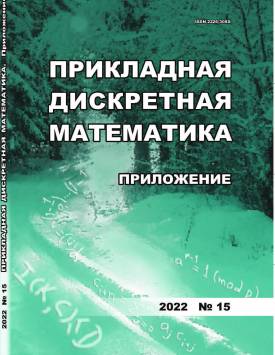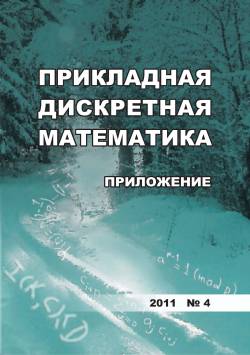The additive differential probability of k successive exclusive-or
We study the additive di erential probability of a composition of bitwise XOR | adp k . For a set of vectors 1 : : : k+1 2 Zn2 , it is de ned as adp k ( 1; : : : ; k ! k+1) = 1 2kn fx1; : : : ; xk 2 Zn2 : Lk i=1 (xi i) = k+1 Lk i=1 xig : It is used when analyzing symmetric key primitives, such as Addition-Rotation-XOR constructions. It is proven that: 1) adp k is a symmetric function; 2) the value of adp k does not change if 2n
Download file
Counter downloads: 20
Keywords
differential cryptanalysis, ARX, XOR, modular additionAuthors
| Name | Organization | |
| Sutormin Ivan A. | Novosibirsk State University; Institute of Mathematics. S. L. Soboleva SB RAS | ivan.sutormin@gmail.com |
References
Shimizu A. and Miyaguchi S. Fast data encipherment algorithm FEAL // LNCS. 1988. V. 304. P. 267-278.
Ferguson N., Lucks S., Schneier B., et al. The Skein Hash Function Family. http://www.skein-hash.info. 2009.
Bernstein D. J. Salsa20 Specification. https://cr.yp.to/snuffle/spec.pdf. 2005.
Bernstein D. J. ChaCha, a Variant of Salsa20. https://cr.yp.to/chacha/chacha-20080128.pdf. 2008.
Aumasson J.-P., Meier W., Phan R. C.-W., and Henzen L. The Hash Function BLAKE. https://www.researchgate.net/publication/316806226_The_Hash_Function_BLAKE. 2014.
Biham E. and Shamir A. Differential cryptanalysis of DES-like cryptosystems //j. Cryptology. 1991. No. 4. P. 3-72.
Lipmaa H., Wallen J., and Dumas P. On the additive differential probability of exclusive-or // LNCS. 2004. V. 3017. P. 317-331.
Mouha N., Kolomeec N., Akhtiamov D., et al. Maximums of the additive differential probability of Exclusive-Or // IACR Trans. Symmetric Cryptology. 2021. No. 2. P. 292-313.
Gligoroski D., Odegard R. S., Mihova M., et al. Cryptographic hash function Edon-R // Proc. IWSCN. 2009. P. 1-9.

The additive differential probability of k successive exclusive-or | Applied Discrete Mathematics. Supplement. 2022. № 15. DOI: 10.17223/2226308X/15/17
Download full-text version
Counter downloads: 793
